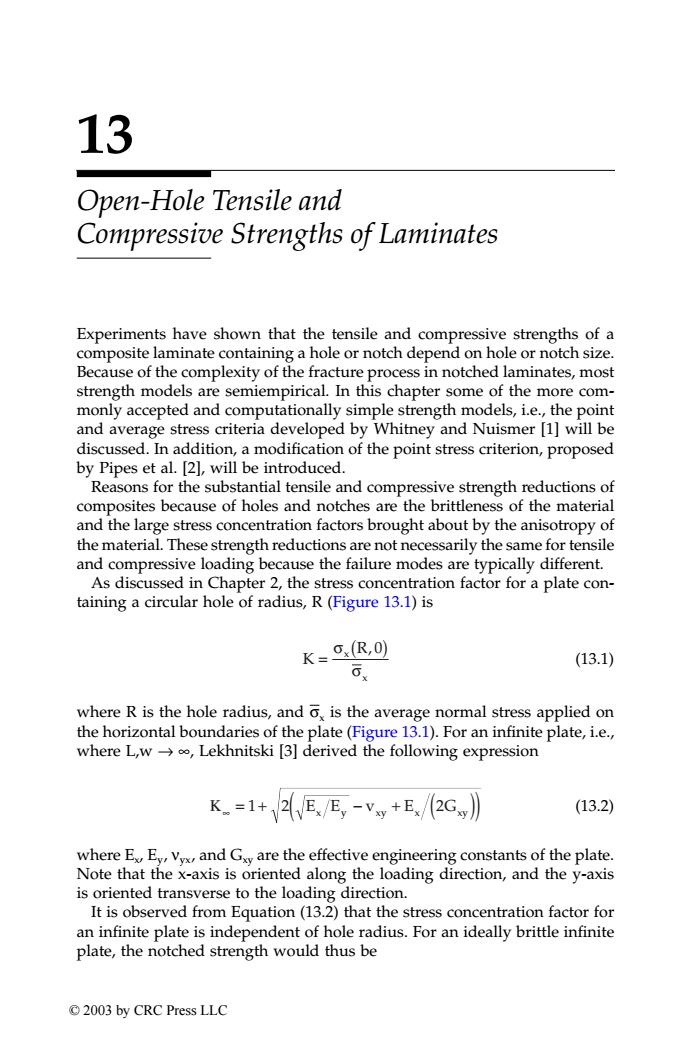正在加载图片...

13 Open-Hole Tensile and Compressive Strengths of Laminates Experiments have shown that the tensile and compressive strengths of a composite laminate containing a hole or notch depend on hole or notch size. Because of the complexity of the fracture process in notched laminates,most strength models are semiempirical.In this chapter some of the more com- monly accepted and computationally simple strength models,i.e.,the point and average stress criteria developed by Whitney and Nuismer [1]will be discussed.In addition,a modification of the point stress criterion,proposed by Pipes et al.[2],will be introduced. Reasons for the substantial tensile and compressive strength reductions of composites because of holes and notches are the brittleness of the material and the large stress concentration factors brought about by the anisotropy of the material.These strength reductions are not necessarily the same for tensile and compressive loading because the failure modes are typically different. As discussed in Chapter 2,the stress concentration factor for a plate con- taining a circular hole of radius,R(Figure 13.1)is K=9(R,0) (13.1) where R is the hole radius,and is the average normal stress applied on the horizontal boundaries of the plate(Figure 13.1).For an infinite plate,i.e., where L,w→∞,Lekhnitski[3]derived the following expression K=1+2E./B,-vy+E/(2G》 (13.2) where EEy,vyx,and Gxy are the effective engineering constants of the plate. Note that the x-axis is oriented along the loading direction,and the y-axis is oriented transverse to the loading direction. It is observed from Equation(13.2)that the stress concentration factor for an infinite plate is independent of hole radius.For an ideally brittle infinite plate,the notched strength would thus be ©2003 by CRC Press LLC13 Open-Hole Tensile and Compressive Strengths of Laminates Experiments have shown that the tensile and compressive strengths of a composite laminate containing a hole or notch depend on hole or notch size. Because of the complexity of the fracture process in notched laminates, most strength models are semiempirical. In this chapter some of the more commonly accepted and computationally simple strength models, i.e., the point and average stress criteria developed by Whitney and Nuismer [1] will be discussed. In addition, a modification of the point stress criterion, proposed by Pipes et al. [2], will be introduced. Reasons for the substantial tensile and compressive strength reductions of composites because of holes and notches are the brittleness of the material and the large stress concentration factors brought about by the anisotropy of the material. These strength reductions are not necessarily the same for tensile and compressive loading because the failure modes are typically different. As discussed in Chapter 2, the stress concentration factor for a plate containing a circular hole of radius, R (Figure 13.1) is (13.1) where R is the hole radius, and σx is the average normal stress applied on the horizontal boundaries of the plate (Figure 13.1). For an infinite plate, i.e., where L,w → ∞, Lekhnitski [3] derived the following expression (13.2) where Ex, Ey, νyx, and Gxy are the effective engineering constants of the plate. Note that the x-axis is oriented along the loading direction, and the y-axis is oriented transverse to the loading direction. It is observed from Equation (13.2) that the stress concentration factor for an infinite plate is independent of hole radius. For an ideally brittle infinite plate, the notched strength would thus be K x R x = σ ( ) σ , 0 Κ∞ =+ − + 12 2 ( ) EE v E G x y xy x xy ( ) TX001_ch13_Frame Page 169 Saturday, September 21, 2002 5:07 AM © 2003 by CRC Press LLC